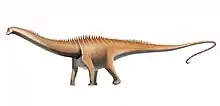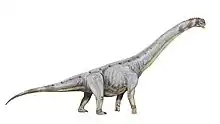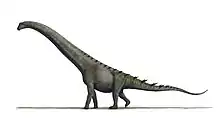Shingopana
Shingopana (meaning "wide neck" in Swahili) is a genus of titanosaurian sauropod from the Lower Cretaceous (Albian age) Galula Formation of Tanzania. It is known from only the type species, S. songwensis.[1] Gorsak & O'Connor's phylogenetic testing suggest Shingopana is more closely related to the South American titanosaur family of Aeolosaurini than any of the titanosaurs found so far in North & South Africa.[1]
| Shingopana | |
|---|---|
| Scientific classification | |
| Kingdom: | Animalia |
| Phylum: | Chordata |
| Clade: | Dinosauria |
| Clade: | Saurischia |
| Suborder: | †Sauropodomorpha |
| Clade: | †Sauropoda |
| Clade: | †Eusauropoda |
| Clade: | †Neosauropoda |
| Clade: | †Macronaria |
| Clade: | †Titanosauria |
| Clade: | †Lithostrotia |
| Genus: | †Shingopana Gorscak et al. 2017 |
| Type species | |
| †Shingopana songwensis Gorscak et al. 2017 | |
Discovery and naming
Part of the holotype was discovered in 2002 by scientists affiliated with the Rukwa Rift Basin Project, which was run by Patrick O'Connor and Nancy Stevens.[1] The rest of the skeleton was excavated during the following years. The genus was officially named in 2017.[1]
Description
Shingopana was a quadrupedal Aeolosaurin sauropod that would have reached up to 8 metres (26 ft) long when fully grown, smaller than the average sauropod.[1]
Skeleton
The holotype was damaged by insect bore holes shortly after the animal died.[1]
Shingopana is known from a partial jaw, represented by the angular bone. Shingopana is also known from four cervical vertebrae; with two of these vertebrae having preserved cervical ribs and another isolated cervical rib. Shingopana instead had remnants of a bulbous expansion on the incompletely preserved cervical vertebrae, which probably helped to strengthen its neck.[1]
Four ribs have been preserved with the holotype, but none are complete. The ribs had flanged edges, but their function is currently unknown.[1]
An almost complete humerus is known and a partial pubis were also discovered.
Classification
Shingopana has been classified witnin the Aeolosaurini. It has been added into the Aeolosaurini cladogram by Silva et al. (2019).[2][3][4]
Palaeoecology
The holotype was discovered in the Upper Cretaceous Galula Formation of the Rukwa Rift Basin in Tanzania. It would have coexisted with the sauropods Rukwatitan[5] and Mnyamawamtuka,[6] the mesoeucrocodiles Pakasuchus[7] and Rukwasuchus,[8] the mammal Galulatherium,[5] an unnamed notosuchian, an unnamed turtle, an unnamed theropod[5] and two types of lungfish (Lupaceradotus and an unanmed genus).
See also
References
- Gorscak, E.; O'Connor, P. M.; Roberts, E. M.; Stevens, N. J. (2017). "The second titanosaurian (Dinosauria: Sauropoda) from the middle Cretaceous Galula Formation, southwestern Tanzania, with remarks on African titanosaurian diversity". Journal of Vertebrate Paleontology. 361 (4): 35–55. doi:10.1080/02724634.2017.1343250.
- Rodrigo M. Santucci and Antonio C. de Arruda-Campos (2011). "A new sauropod (Macronaria, Titanosauria) from the Adamantina Formation, Bauru Group, Upper Cretaceous of Brazil and the phylogenetic relationships of Aeolosaurini" (PDF). Zootaxa. 3085: 1–33.CS1 maint: uses authors parameter (link)
- França, M.A.G.; Marsola, J.C.d A.; Riff, D.; Hsiou, A.S.; Langer, M.C. (2016). "New lower jaw and teeth referred to Maxakalisaurus topai (Titanosauria: Aeolosaurini) and their implications for the phylogeny of titanosaurid sauropods". PeerJ. 4: e2054. doi:10.7717/peerj.2054. PMC 4906671. PMID 27330853.
- Silva, J.C.G. Jr.; Marinho, T.S.; Martinelli, A.G.; Langer, M.C. (2019). "Osteology and systematics of Uberabatitan ribeiroi (Dinosauria; Sauropoda): a Late Cretaceous titanosaur from Minas Gerais, Brazil". Zootaxa. 4577 (3): 401–438. doi:10.11646/zootaxa.4577.3.1.
- O’Connor, Patrick M.; Gottfried, Michael D.; Stevens, Nancy J.; Roberts, Eric M.; Ngasala, Sifa; Kapilima, Saidi; Chami, Remigius (March 2006). "A new vertebrate fauna from the Cretaceous Red Sandstone Group, Rukwa Rift Basin, Southwestern Tanzania". Journal of African Earth Sciences. 44 (3): 277–288. doi:10.1016/j.jafrearsci.2005.11.022. ISSN 1464-343X.
- Gorscak, Eric; O’Connor, Patrick M. (2019). "A new African titanosaurian sauropod dinosaur from the middle Cretaceous Galula Formation (Mtuka Member), Rukwa Rift Basin, southwestern Tanzania". PLoS ONE. 2 (14): e0211412. doi:10.1371/journal.pone.0211412. PMC 6374010. PMID 30759122.
- O’Connor, Patrick M.; Sertich, Joseph J. W.; Stevens, Nancy J.; Roberts, Eric M.; Gottfried, Michael D.; Hieronymus, Tobin L.; Jinnah, Zubair A.; Ridgely, Ryan; Ngasala, Sifa E. (August 2010). "The evolution of mammal-like crocodyliforms in the Cretaceous Period of Gondwana". Nature. 466 (7307): 748–751. doi:10.1038/nature09061. ISSN 0028-0836. PMID 20686573.
- Sertich, Joseph J. W.; O’Connor, Patrick M. (2014-04-16). "A new crocodyliform from the middle Cretaceous Galula Formation, southwestern Tanzania". Journal of Vertebrate Paleontology. 34 (3): 576–596. doi:10.1080/02724634.2013.819808. ISSN 0272-4634.












